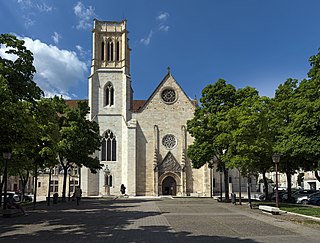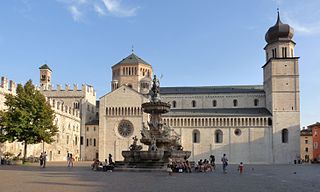The First Council of the Lateran was the 9th ecumenical council recognised by the Catholic Church. It was convoked by Pope Callixtus II in December 1122, immediately after the Concordat of Worms. The council sought to bring an end to the practice of the conferring of ecclesiastical benefices by people who were laymen, free the election of bishops and abbots from secular influence, clarify the separation of spiritual and temporal affairs, re-establish the principle that spiritual authority resides solely in the Church and abolish the claim of the Holy Roman Emperor to influence papal elections.

Pope Boniface VIII was the head of the Catholic Church and ruler of the Papal States from 24 December 1294 to his death, in 1303. The Caetani family was of baronial origin, with connections to the papacy. He succeeded Pope Celestine V, who had abdicated from the papal throne. Boniface spent his early career abroad in diplomatic roles.
The Council of Piacenza was a mixed synod of ecclesiastics and laymen of the Roman Catholic Church, which took place from March 1 to March 7, 1095, at Piacenza.
Decretals are letters of a pope that formulate decisions in ecclesiastical law of the Catholic Church.
A commendatory abbot is an ecclesiastic, or sometimes a layman, who holds an abbey in commendam, drawing its revenues but not exercising any authority over its inner monastic discipline. If a commendatory abbot is an ecclesiastic, however, he may have limited jurisdiction.
In the jurisprudence of the canon law of the Catholic Church, a dispensation is the exemption from the immediate obligation of law in certain cases. Its object is to modify the hardship often arising from the rigorous application of general laws to particular cases, and its essence is to preserve the law by suspending its operation in such cases.
Cathedraticum is a specified sum of money to be paid annually toward a bishop. It is a mark of honour and a sign of subjection to the cathedral church, from which its name is derived.
The right of patronage in Roman Catholic canon law is a set of rights and obligations of someone, known as the patron in connection with a gift of land (benefice). It is a grant made by the church out of gratitude towards a benefactor.

The Diocese of Agen is a Latin Church ecclesiastical territory or diocese of the Catholic Church in France.
The Corpus Juris Canonici is a collection of significant sources of the Canon law of the Catholic Church that was applicable to the Latin Church. It was replaced by the 1917 Code of Canon Law which went into effect in 1918. The 1917 Code was later replaced by the 1983 Code of Canon Law, the codification of canon law currently in effect for the Latin Church.
Within the Catholic Church, an ecclesiastical judge is an ecclesiastical person who possesses ecclesiastical jurisdiction either in general or in the strict sense. The judge presides over all baptized persons within their jurisdiction.
The Liber Septimus may refer to one of three Catholic canon law collections of quite different value from a legal standpoint which are known by this title.

The Archdiocese of Auch-Condom-Lectoure-Lombez, more commonly known as the Archdiocese of Auch, is a Latin Church ecclesiastical territory or archdiocese of the Catholic Church in France. The archdiocese now comprises the department of Gers in south-west France. The archdiocese is a suffragan of the Archdiocese of Toulouse, and the current bishop, who therefore does not wear the pallium, is Maurice Marcel Gardès, appointed in 2004.

The Diocese of Ventimiglia-Sanremo is a Latin diocese of the Catholic Church in Liguria, northern Italy. The name of the historic Diocese of Ventimiglia was changed in 1975. It was originally a suffragan diocese of the Metropolitanate of Milan up to 1806, when it was transferred to the Metropolitanate of Aix; but it has been a suffragan of the Archdiocese of Genoa since 1818.
The Latin Catholic Diocese of Muro Lucano, in the southern Italian region of Basilicata, existed until 1986. In that year it was united into the archdiocese of Potenza-Muro Lucano-Marsico Nuovo.

The Archdiocese of Trento is a Latin Metropolitan archdiocese of the Catholic Church in the Triveneto, named after its see in Alpine Italy, Trento, in Trentino-Alto Adige region.
The conditions for the canonical erection of a house of religious are indicated in canons 608-611 of the 1983 Code of Canon Law.
Canonical institution is a technical term of the canon law of the Roman Catholic Church, meaning in practice an institution having full recognition and status within the Catholic Church.
In the canon law of the Catholic Church, canonical provision is the regular induction into a benefice.
The Catholic Church utilizes the oldest continuously functioning legal system in the West, much later than Roman law but predating the evolution of modern European civil law traditions. The history of Latin canon law can be divided into four periods: the jus antiquum, the jus novum, the jus novissimum and the Code of Canon Law. In relation to the Code, history can be divided into the jus vetus and the jus novum. Eastern canon law developed separately.





